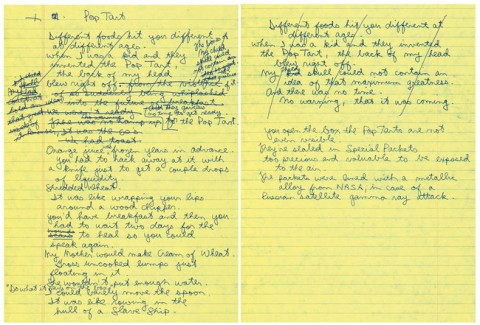It seems that a limited number of personality types best suit the job of cinematic auteur. A few examples: there’s the reclusive perfectionist (Kubrick, Malick), the mystic poet (Bresson, Tarkovsky, also Malick), the quirky manchild (Wes Anderson, Michel Gondry), the bratty student of hip (Godard, Tarentino), the hyper-literate, neurotic Manhattanite, jazz-playing Jewish comedian…. Okay, fine, it’s an imperfect system. Only one director fits that last one, but he deserves his own category. And when Jean-Luc Godard decided to make a film about an interview with Woody Allen in 1986, he seemed to agree. But in reality, the short piece above is a hybrid; the film begins with Godard’s poetic, ruminative voice-over in French, and as a view of Central Park comes into focus (from a window in the Plaza, it appears), Gershwin’s “Rhapsody in Blue” begins to play. The title– Meetin’ WA—is a Godardism, appropriating corny American speech patterns with its faux-folksy dropped “g.”
But there are plenty of Allenisms as well, like the jazz interludes and silent-film title cards announcing each topic. Ultimately, Godard swipes these tropes as fodder for his own stylistic eccentricities (jarring, offbeat cuts, self-referentiality) as the two discuss stylistic distinctions, even as their styles meet, awkwardly, on the screen. For example, Allen says of the title cards that Godard uses them as a cinematic device, while he thinks of them as literary devices. This seems to mark a very important difference between the two directors: Godard is a rapacious reader and redeployer of the language of film, while Allen’s films are more novelistic, prioritizing psychological realism and verbal humor over manipulation of the image.
The interview is primarily in English, save certain moments when Godard needs to revert to French to get a point across (he has a translator). For lovers of these two directors, or of film in general, their conversation will fascinate. But it seems fair to say that without Godard’s editorial interventions (or interruptions, as the case may be), it wouldn’t look like much. Allen mostly sits slumped on a drab hotel couch while the camera trains on him from behind Godard’s shoulder, so that the latter isn’t visible at all. Then about halfway through, we cut away: while their conversation continues, we watch a scene of Godard sitting on the floor of a bright blue room, sifting through a box of VHS tapes and slamming them on a table in seeming disgust. This scene marks a central point of their discussion—what to make of the loss of cinema qua cinema as TV and video took over.
Now, as screens get even smaller, budgets bigger, and attention spans considerably more reduced, the movies must work harder to retain a viewing audience, and the situation for artists like these two is even more precarious. In a sweeping dramatic gesture, Godard has recently proclaimed “the death of cinema”—a very European thing to do, it seems, like Barthes’ death of the author or Ortega y Gasset’s death of the novel. Allen soldiers on, recently making what many have called his best film in decades, which may also be his most self-consciously literary—a film that warns against the dangers of nostalgia even as it looks back obsessively to Allen’s beloved jazz age. Maybe this meeting of Godard and Allen represents a time-capsule curio we look back on, from the other side, after the death of the auteur.
You will find Meetin’ WA listed in our collection of 500 Free Movies Online.
Related Content:
Jean-Luc Godard’s After-Shave Commercial for Schick (1971)
Ingmar Bergman’s Soap Commercials Wash Away the Existential Despair
Fellini’s Fantastic TV Commercials
Josh Jones is a writer and scholar currently completing a dissertation on landscape, literature, and labor.



